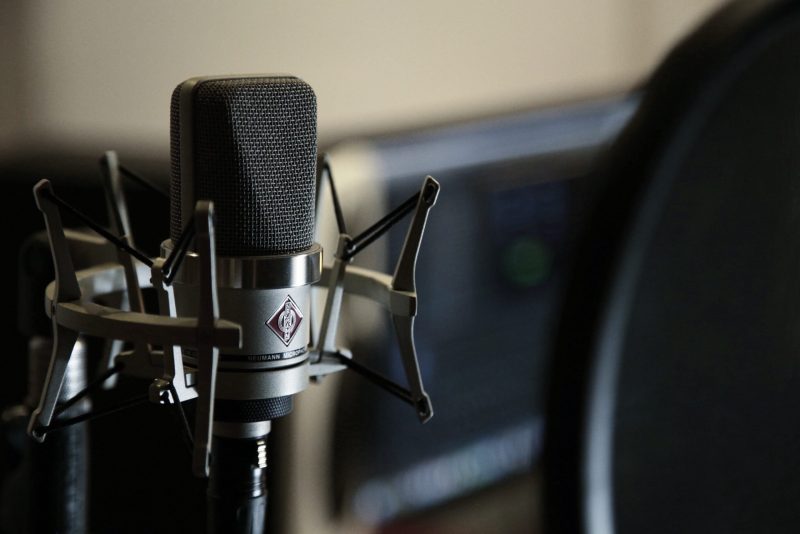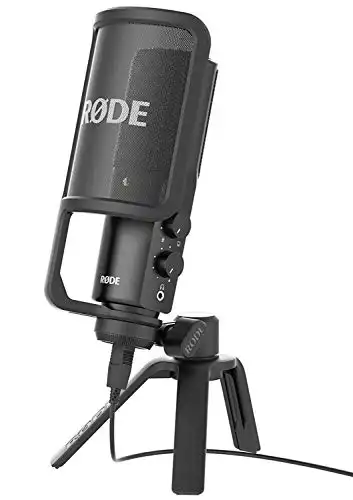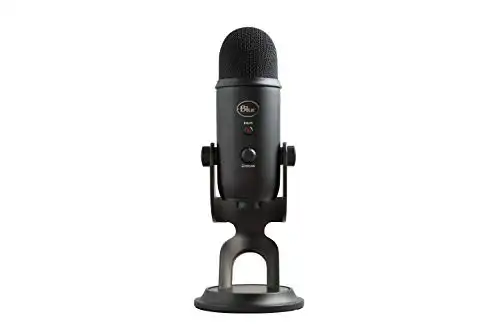Among all the microphones you can use to create the excellent sound quality needed for podcasting, two are the most revered among professionals and amateurs. They are the
But what makes them the best? They are pretty different from each other, after all, so how can you be confident that one is going to be better for your podcast than the other?

To answer these questions and give you a better idea of the differences between the two, let’s dig into the specifications and features that make them world-class podcasting microphones.
Let’s begin by looking at what each has to offer individually.
Table of Contents
Rode NT USB Microphone
Let’s start with the
The NT USB is built with a condenser transducer, often the preferred style for podcasting because it tends to give a much more natural sound when recording vocals. It has a cardioid pattern that works across a 180º arc directly in front of it, meaning it picks up less ambient background noise to muddy the vocal.
It’s easy to use, connecting to an audio interface or mixer through the USB port, while the 3.5mm stereo headphone jack allows you to perform zero-latency monitoring. Podcasters – in fact, anyone who uses microphones a lot – will know that’s always a great extra feature to find.
Two sets of controls are built into the
Pop filters help produce clear vocals by removing any noise created by intakes of breath or the ‘popping’ noises that can come from pronouncing certain letters. The first ‘P’ in ‘Pop’ is an example because you push air out when you pronounce it, and without a filter, that can block out your sound for a second. A pop filter comes with this microphone, a useful additional accessory.
The NT USB also comes with a tripod desk stand, which is especially useful for podcasting when you need your microphone to stay as steady as possible. You also have the option to use the included ring mount to keep it in place. Meanwhile, the 6m USB cable will allow you some flexibility over your studio setup.
One thing the
The build quality of the NT USB is sturdy, and you’ll feel you’ve invested in a microphone that will last you a long time.
See the Latest Pricing on Amazon
Summary
What’s in the box?
- Rode NT USB Microphone
- Pop Filter
- Tripod Desk Stand
- Ring Mount
- Storage Pouch
Specifications:
- Cardioid Polar Pattern
- Headphone Jack
- Volume Control Dial
- Direct Mix Control Dial
- 6m USB Cable
- Frequency Response: 20Hz – 20KHz
- Sample Rate: 48KHz/16-bit
- Max SPL: 110dB
- Weight: 520g
User experience
The
Customers are generally happy with the mic, praising its sound and build quality. However, some users have found that the mic is incompatible with the
Additionally, users noted how this microphone works exceptionally well for podcasting and gaming, though recording vocals had its flaws.
The reviews feature favorable comments, and customers find that the microphone exceeded their expectations.
Blue Yeti USB Microphone
Blue Microphones is another world-renowned brand famous for creating high-quality recording equipment. The Blue Yeti USB condenser microphone is another addition to the company’s arsenal of impressive creations.
This microphone’s USB Plug & Play connectivity makes it incredibly easy to install and use with an audio interface or mixer. Alternatively, you can plug it directly into your podcasting laptop and use it with your preferred recording program.
It works with both Windows and Mac OS, giving you the flexibility to switch between computers without needing to buy a separate system-compatible microphone.
This microphone is also incredibly versatile and features a total of four (yes, four!) different pickup patterns. You can switch between cardioid, omnidirectional, bidirectional, and stereo. That allows you to record in various ways using just one microphone, rather than needing a space-consuming (not to mention expensive) setup of multiple microphones.
So no matter what the theme of your podcast is or how many guests you’re featuring at a time, this microphone can handle your requirements.
Unlike the
As with the
If there’s a downside to the
While they don’t come as part of the package, the
See the Latest Pricing on Amazon
Summary
What’s in the box?
- Blue Yeti USB Microphone
- USB Cable
Specifications:
- Three built-in condenser capsules
- Multiple Pickup Pattern Selection; Cardioid, Omnidirectional, Bidirectional & Stereo
- Gain Control Dial
- Volume Control Dial
- Headphone Jack
- Mute Button
- Mac & PC Compatible
- USB Connection
- Desk Stand (already attached to the microphone)
- Frequency Response: 20Hz – 20KHz
- Sample Rate: 48KHz/16-bit
- Max SPL: 120dB
- Weight: 1.2lbs
User experience
In online reviews, the
The commentary was primarily positive, with people highlighting its reliability and quality. Some said that it was perfect for non-professionals who still wanted great sound.
Some users note that the mic is especially well-suited for recording video, while others find it ideal for streaming. Overall, the model has been proven convenient for multiple purposes.
According to user experience, most people are satisfied with their purchase and recommend this microphone to anyone looking for a high-quality yet affordable option.
Which Is Better For Podcasting?
As you can see, each microphone comes with a set of unique features that separates it from the other, and the easiest way to decide which of these two microphones is better for podcasting is to assess the format of your podcast itself.
Let’s look at the most critical factors you need in a podcasting microphone and how those factors might steer you toward either the
Audio Quality
Pickup Pattern
Most podcasting microphones allow you to choose between a cardioid or an omnidirectional pickup pattern. The
The
To decide whether the
An omnidirectional microphone works across a 360º arc and picks up vocals from different directions. It also has a low-frequency response, so it will be able to make vocals sound clearer while reducing background noise.
Cardioid patterns work across a 180º arc and focus more on vocals coming from directly in front of the microphone, which simultaneously blocks out background noise.
So, if your podcast has a lot of guests or co-hosts, the
Built-In Controls
Most of the time, you’ll use your computer for the majority of your audio level adjustments. But the ability to quickly change the sound quality while you’re recording can be instrumental.
You can use the audio coming from your microphone, the audio coming from your computer, or a mixture of both. The
These features are straightforward to use and helpful to have once you’ve hit the record button.
More built-in control options are found on the
The
Connection
One feature that the
Accessories & Style
One area in which the
A pop filter is one of the most useful accessories included with the
The
However, one trump card that the
Final Word
The
Generally speaking, go with the
More extensive operations, professional studios, and podcasts that have multiple hosts and guests – grab yourselves a Blue Yeti. Switching between four different pickup patterns and the variety of built-in controls will allow you to record in several ways without changing equipment. It will also give you more control over the sound quality while recording, making editing much more effortless.
Frequently Asked Questions
Does the Blue Yeti mic pick up background noise?
Any microphone will pick up background noise, but the
In addition, the Yeti has a low-noise preamp and a built-in pop filter. These features also help to reduce the level of background noise that is picked up by the microphone.
What is a good USB microphone?
Aside from the featured ones, there are plenty of other great models. The
If you’re looking for more affordable mics, you may want to check out the PreSonus Revelator, Razer Seiren, and
How do I choose a USB microphone?
If you’re looking for a quality USB microphone, there are a few things you’ll want to keep in mind.
First, choosing a large diaphragm condenser mic is essential, as these produce superior sound quality. Second, look for a mic with a 20-20,000 Hz frequency range, as this will ensure you can capture a wide range of frequencies.
Also, zero-latency headphone monitoring is essential for recording vocals, so choose a mic that offers this feature. Finally, for best results, consider opting for a 24-bit mic.

